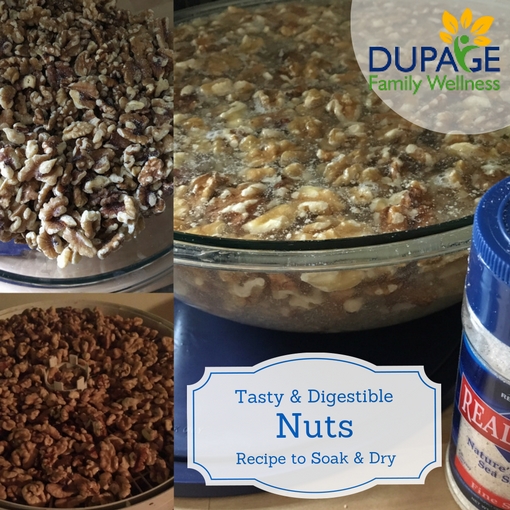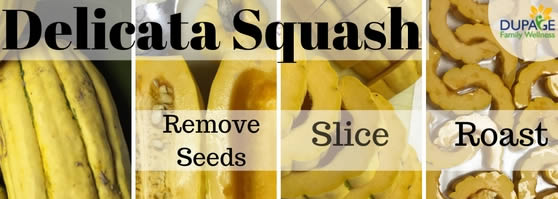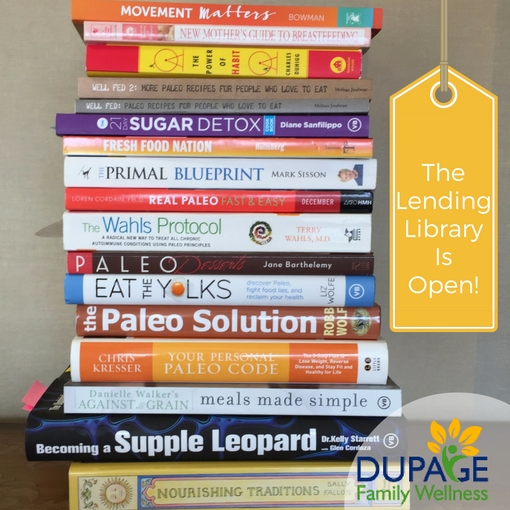
It is easy to make store bought nuts even tastier, and at the same time, easier to digest.
Nuts are nutrient dense, and provide a good balance of fat and protein, along with omega 3 fatty acids! They can be a great food for most people.
What Problem Occurs with Eating Raw Nuts?
One of the downsides to nuts is that they contain enzyme inhibitors like phytic acid. In nature, phytic acid prevents the seed from sprouting prematurely, safeguarding the nut until proper growing conditions occur. Unfortunately for humans, phytic acid can be considered an "anti-nutrient" because it binds to minerals (e.g. calcium, zinc, magnesium, iron, and copper) making them unavailable for the body, and inhibits enzymes that aid in digestion.
Although nuts are considered a nutrient dense, "healthy" food, the body will not benefit as much from nuts if the nutrients are not digested and absorbed. In addition, whole grains and seeds also have high levels of phytic acid, so eating them with nuts makes the problem worse. Read more about phytic acid. in nuts, grains, and seeds.
How Do You Solve This Problem?
It's easy! Soak and dry the nuts.
Our ancestors soaked nuts, seeds, and grains to start the process of breaking them down and making them easier to digest!
How Do The Nuts Taste?
I did a side by side taste test of soaked and dried nuts vs. nuts straight out of the bag. There is a definite difference. Nuts out of the package have a slightly bitter taste that is absent with the soaked and dried nuts!
Recipe to Soak and Dry Nuts
Ingredients:
- Nuts - any kind you like. For example: almonds, cashews, hazelnuts, pecans, pine nuts, walnuts, macadamia nuts, or brazil nuts. Note: Peanuts are not a nut, they are a legume, and have their own issues that are outside the scope of this recipe.
- Filtered water
- 1 TBSP sea salt
Directions:
-
Place nuts in a large glass bowl or mason jar
-
Cover completely with filtered water
-
Add sea salt and stir
-
Cover and let sit overnight or up to 24 hours
-
Drain and rinse nuts and lay them out on trays of dehydrator
-
Dry at a low temperature (about 105-150 degrees) for about 24 hours. If you don’t have a dehydrator, bake them in the oven at the lowest temperature of your oven for 12-24 hours.
-
Enjoy! Store your dried nuts in the refrigerator or freezer for best quality.
Soaking and drying nuts is not difficult, but it does take some time. I urge you to give it a try, and observe the difference. Let me know what you find on facebook!
Dr. Jamie Thomure
 I have some deep thoughts for you this week. Stay with me because this one is really important! Recently I was challenged to think about the priorities in my life! I sat down and figured out what is important to me. Here is what I came up with.
I have some deep thoughts for you this week. Stay with me because this one is really important! Recently I was challenged to think about the priorities in my life! I sat down and figured out what is important to me. Here is what I came up with.
My health is the most important thing to me. If I don’t have my health, I don’t have anything. Being healthy is what gives me great quality of life!
I had to further break this down. What contributes to health? What do I need to do to maintain my health? I realized that these were many of the things that I chat with you about in my weekly challenges:
- Eat nutritious food
- Move my body
- Spend time with friends and family (Social Wellness)
- Spend time outside
- Sleep Well (I haven’t talked about this one yet, but I will. It is important!)
- Reduce stress (I also need to write about this!)
Does Your Time Match Your Priorities?
After you figure out what is important to you, look at your typical day. How much time do you spend on the activities you just listed above? How much of your day is spent on things that are not important to you. If you noticed that the bulk of your time isn't spent doing what you prioritized- how can you improve?
Stacking your life
Stacking Your Life is a new concept that I learned recently from Katy Bowman (Author of Movement Matters). "Stacking Your Life" is doing one task that contributes to several goals at the same time. It isn’t multi-tasking, which is trying to do multiple tasks as the same time. Stacking Your life is a way to purposefully change your activities to better fit your life goals and priorities. There are only 24 hours in a day, so getting the most out of each hour is important!
Here is how I used the concept of "stacking my life" to use my free time to the fullest.
- Since eating healthy and spending time with family is important, my husband and I spend several hours together preparing healthy food for the week on weekends. This allows us time together. When our schedules get busier during the week, we have already prepared healthy meals so we don’t just grab takeout or go out to eat. Having a plan also reduces stress for me because I don’t feel the pressure to figure out a good dinner at the last minute.
- Movement is a priority. I want to move my body as much as possible every day. I also want to spend time with friends and family. I have decided to take my daughter on walks, rather than driving to the gym. I carry her in my arms to I get my upper body workout. This gets us both movement time, family time, and outdoor time. Rather than meeting friends out to eat (typically unhealthy food and too much sitting)- I meet friends for outdoor walks!). I also find that natural movement reduces stress. There have been times in my life where much of my social life was through my gym. Taking an inventory of your priorities will help you figure out what makes the most sense for you.
- When planning weekend activities, we keep our health goals in mind:
- Go for a walk at the arboretum instead of watching a movie
- Shop at a farmer’s market instead of a grocery store (outdoor time!)
- When it comes time to clean the house, we recently started setting a timer for 20 minutes each night and cleaning together during that time. While cleaning isn't listed as a "priority"- it is important because when it gets messy, both of our stress levels go up. Working on it together not only gets it done faster, but it becomes a family activity!
What have we cut out to help our life fit our priorities?
We used to spend quite a bit of time watching TV in the evenings. While we haven’t cut out all TV, we now go on family walks in the evening, and spend time on the floor playing with the baby. If the weekend was too busy for meal prep, week nights are our backup time for getting healthy food prepared.
My husband and I have noticed is that it is easy to get sucked into playing on our phones. Now we try to put our phones away as much as possible when we get home so we spend time together.
Does your money go toward your priorities?
We need money to live. We should not live to make money. It is important to consider where our money is going, and if this is in line with our priorities. Earning enough money can be an added stress and time user that makes our other goals hard to reach. Many of us spend 8+ hours each day working to make money for all of the other “things” in our lives. When my husband and I went through our budget- we found that there were some of these things that we spent money on that didn’t necessarily contribute to our goals and priorities. Obviously having a roof over our head, paying our utility bills, and putting good food on the table are crucial. but have you ever analyzed all of the other things that you buy that we often don’t really need? Here are some examples of some changes we’ve made:
- We have tried stop eating out at restaurants. It is more expensive for typically less healthy food.
- We look for free or cheap entertainment (e.g. parks, walking, games, etc.) since what we remember is the time spent together, and not whatever expensive show or event we might have missed.
- We don’t buy things just because they are on sale or cheap. Before buying something, we think- "Do we really need this?" If not, we leave it on the shelf. It’s amazing how much money you can spent on a little run to Target. Even with this mentality, we have still managed to accumulate our fair share of "things" and are working on selling/donating some of our extra possessions.
- When we had a family birthday party for our daughter- we valued spending time with our guests and feeding them good quality homemade food. We decided not to spend money on decorations and party favors.
- We don’t buy new cars, and are planning on driving our old cars for a very long time to avoid having a car payment
- We don’t live in a house that overstretches our budget. When buying a house, it is often easy to qualify for a house that stretches your budget adding stress each month. We find that we spend 90% of our time at home either in the kitchen, family room or bedroom- and don’t need a ton of extra square footage.
When you look at your cash flow, you might realize that you are spending quite a bit of money on things that don't add value to your life. Cutting in these areas could allow you to save more money, pay off your credit card, or decide that it would be okay to earn less money and spend less of your time working.
Everyday patients give me excuses about why they can’t eat healthy (too expensive, takes too much time), why they can’t exercise (no time), why they don’t get enough sleep, etc. My answer is that it is all about your priorities and choices. If something is a priority and important to you, then you will figure out a way to do it!
This week, think about what you value in life, and what would help you reach these priorities. How you could change your daily routine to make your life mirror your priorities?
I'd love to hear your ideas to "Stack You Life". Chat with me on facebook.
Dr. Jamie Thomure

Balance is often overlooked, yet it is an important component of healthy movement. If we can’t balance, we aren’t stable. If we aren’t stable we don’t have a platform for our joints to move from. If we don't a platform to move from, our muscles become "tight" to try to create more stability.
How did we get into this situation?
Do you spend most of your day sitting? This takes very little “balance", especially if you are leaning back on the chair or couch. When you stand or walk, it is probably on flat ground with flat shoes. Most surfaces are cement, paved, or otherwise "flattened". Think about it .... How often do you challenge your body’s systems to balance? Our ancestors had a more adventurous life. They walked on non-uniform surfaces (e.g. fields, forests etc.) to perform daily outdoor activities and even used logs and stepping stones to cross rivers.
Benefits of Balance
Studies link balance training to injury prevention both in athletes and seniors. Balance training was found to be more helpful that stretching for injury prevention. Specifically it has been linked to reduction in ankle sprains and ACL injuries. In older individuals, balance is the key to reducing the risk of falls, which can lead to broken bones and other serious complications.
Whether you are young or old, balance is important for improving your stability as you move.
How Does Balance Work?
Your body has 3 systems that work together to help you balance:
- Nerve fibers called proprioceptors on the bottoms of your feet: These send signals up to your brain, telling it how much pressure is on each part of your foot. Your weight shifts accordingly to stay centered and stable.
- Vision: Your eyes focus on the horizon or a stable object, and send signals to your brain. These help the brain understand where the head is in space so that it can stabilize your body.
- Ear Canals: You have 3 semi-circular canals in your ears filled with fluid. One canal is in each plane. As your head moves, the fluid shifts and stimulates receptors to let your brain know where your head is at in space.
Balance is easiest when both feet are on a stable surface, your eyes are open, and your head is still. Removing any one of these systems (i.e. lifting a foot or standing on an unstable surface, closing our eyes, or moving our head around) makes balancing much more difficult.
Test Your Balance
Can you stand on one foot for 60 seconds without touching the other foot to the ground? If not, you need some practice! Even if this is easy for you, there are still ways to further improve your balance by only utilizing 1 or 2 of the above systems as opposed to all 3! Here are some tips.
Improve Your Balance
Fortunately, balance can be improved if you work on it! Like other forms of movement, the “use it or lose it” principle applies. If you don’t use the systems that your body has put in place for balance, they become less effective. Over time, your balance will get worse. The good news, is that you can turn this around.
Here are a few ideas for you to improve your balance:
- Practice Balancing: Use the principles above to challenge your body. Start with simply balancing on one foot on a stable surface. Once you are good at this and can do it for a full minute, try challenging yourself by standing on a folded blanket, pillow, grass or sand (unstable surface), closing your eyes, or moving your head around while balancing.
- Find Uneven Surfaces to Explore: Get out in nature and find some naturally unstable or narrow surfaces explore. This could mean hiking over roots and rocks. Anything that isn’t perfectly flat like a floor will start to challenge your body and force it to improve its ability to stabilize you. Even if you are in a parking lot you can practice walking on a man made balance beam such as a parking curb.
- Try a class or activity that gets your body doing alternative movements:. For example, in a dance class you control your body through all sorts of movements, often with only 1 foot on the ground. Other ideas include Tai Chi, Martial Arts, playing a game like raquetball, tennis, or pickleball.
Looking for a class? Here are a few local options that I love!
Zumba- While zumba isn't solely focused on balance, it does involve moving your body in all sorts of positions- many of which are on one foot. It is a Latin Dance workout class that feels more like a party than exercise! There is a local instructor named Tom that puts on by far the best Zumba class I've ever gone to! His energy is contagious he makes moving fun! If you haven't tried it, he teaches at Fit to be You- a new studio in Naperville!
Nia- I recently attended a Nia class. Nia is another dance fitness class that emphasizes joint mobility, stability, flexibility, balance, and body awareness. It is done barefoot (so all of the little joints in your feet can freely move and aren't restricted by shoes). It is totally adaptable for all age and fitness levels. It is taught at Warrenville Park and Wheaton Sports Center if you are local. If not, you can visit www.nianow.com to find a class near you!
So your challenge this week is to incorporate more balance into your life! This can be through simply practicing with the strategies listed above, exploring uneven surfaces, or finding a class to attend! I'd love to hear how it goes- or if you have any other ideas for improving your ability to balance! Chat with me on my facebook page!
-Dr. Jamie Thomure
There are fall vegetables are at the farmer's market now. Don't be afraid to try something new. I'll share 3 that I've tried this week.

Brussels Sprouts
A "tree" of brussels sprouts is the size of a baseball bat. It's a fun farmer's market find. Just cut the brussels sprouts off of the stem, cut them in half and roast. If you need more guidance on how to make them taste good. check out this post from a few months ago called Making Vegetables that Taste Good.
Butternut Squash
There are a few different ways I like to use butternut squash. If you haven't prepared it before, it might be intimidating. This You Tube video shows 4 ways to get started with a butternut squash, depending on how you are going to use the squash and how much time you have. You can use any of the methods in the video to prepare your squash for the following recipes.
1) Roasted Squash: If I want cubes of roasted butternut squash I peel and cube it before roasting (see the 3rd method in video for cutting demo). It is a delicious side on it's own or a tasty addition to a salad!
2) Mashed Butternut Squash- Mash the squash after it has been baked to soften it. I add ingredients like butter ( a few tablespoons), garlic, salt and pepper. If I'm feeling crazy, I add a little honey and /or cooked bacon! If you want a specific recipe with more details here is a good mashed squash recipe.
3) Roasted vegetable soup: Roast the squash as described above, cover with broth, and blend with immersion blender. The possibilities for seasonings and additions are endless. I typically use what I have on hand, and adding additional veggies and whatever spices I have handy. This week it was roasted carrots, red peppers, onion, and garlic in my soup. I seasoned it with cumin, paprika, chili powder, salt and pepper. If you want more guidance than this for soup making, here is one that I like.
Butternut Squash - Pear Soup
Ingredients:
- 1 Butternut Squash - roasted to soften it, and cut into small pieces.
- 3 ripe Bartlett pears - cored & chopped (other recipes peel, but I don't bother)
- 1 can coconut milk
- 4-5 cups chicken broth
- 1 onion - chopped
- 2 cloves garlic
- 1 t salt
- 2 t grated ginger
- 1 T curry powder
- 3 T Butter
Instructions
- Prepare squash into 1 inch chunks.
- Melt butter and add onion, garlic, curry powder and ginger in a large saucepan Stir about 5 minutes until onions are soft, but not brown.
- Add squash, pears, stock and salt. Cook over medium heat about 30 minutes.
- Using immersion blender, blend mixture until smooth.
- Stir in coconut milk.
Serve and Enjoy!
Delicata Squash 
Delicious! My new favorite because it it so easy to prepare, and has a great sweet taste. The half circles with scalloped edges add a fun shape to your dinner plate Follow the roasted vegetable directions and I promise you won't be disappointed!
Other delicata squash benefits:
- Easy to cut when raw - no struggle with tough skin.
- Eat the skin too - no need to peel.
These are a few simple fall recipes to inspire you to get cooking! Let us know if you try any of these recipes and how it turns out! If you are at the farmer's market, and find a vegetable that you don't know what to do with, post it on our facebook page! We'd love to help!
- Dr. Jamie Thomure




 I have some deep thoughts for you this week. Stay with me because this one is really important! Recently I was challenged to think about the priorities in my life! I sat down and figured out what is important to me. Here is what I came up with.
I have some deep thoughts for you this week. Stay with me because this one is really important! Recently I was challenged to think about the priorities in my life! I sat down and figured out what is important to me. Here is what I came up with.


